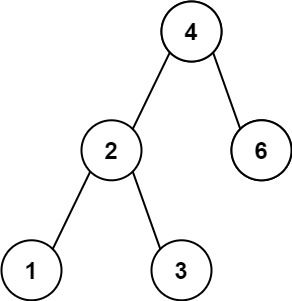二叉树 ● 530.二叉搜索树的最小绝对差 ● 501.二叉搜索树中的众数 ● 236. 二叉树的最近公共祖先
《530.二叉搜索树的最小绝对差》
给你一个二叉搜索树的根节点 root ,返回 树中任意两不同节点值之间的最小差值 。
差值是一个正数,其数值等于两值之差的绝对值。
示例 1:
输入:root = [4,2,6,1,3] 输出:1
示例 2:
输入:root = [1,0,48,null,null,12,49] 输出:1
//递归
class Solution {
TreeNode pre;// 记录上一个遍历的结点
int result = Integer.MAX_VALUE;
public int getMinimumDifference(TreeNode root) {
if(root==null)return 0;
traversal(root);
return result;
}
public void traversal(TreeNode root){
if(root==null)return;
//左
traversal(root.left);
//中
if(pre!=null){
result = Math.min(result,root.val-pre.val);
}
pre = root;
//右
traversal(root.right);
}
}
//迭代法-中序遍历
class Solution {
TreeNode pre;
Stack stack;
public int getMinimumDifference(TreeNode root) {
if (root == null) return 0;
stack = new Stack<>();
TreeNode cur = root;
int result = Integer.MAX_VALUE;
while (cur != null || !stack.isEmpty()) {
if (cur != null) {
stack.push(cur); // 将访问的节点放进栈
cur = cur.left; // 左
}else {
cur = stack.pop();
if (pre != null) { // 中
result = Math.min(result, cur.val - pre.val);
}
pre = cur;
cur = cur.right; // 右
}
}
return result;
}
}
《501.二叉搜索树中的众数》
给你一个含重复值的二叉搜索树(BST)的根节点 root ,找出并返回 BST 中的所有 众数(即,出现频率最高的元素)。
如果树中有不止一个众数,可以按 任意顺序 返回。
假定 BST 满足如下定义:
- 结点左子树中所含节点的值 小于等于 当前节点的值
- 结点右子树中所含节点的值 大于等于 当前节点的值
- 左子树和右子树都是二叉搜索树
示例 1:
输入:root = [1,null,2,2] 输出:[2]
示例 2:
输入:root = [0] 输出:[0]
//暴力法
class Solution {
public int[] findMode(TreeNode root) {
Map map = new HashMap<>();
List list = new ArrayList<>();
if (root == null) return list.stream().mapToInt(Integer::intValue).toArray();
// 获得频率 Map
searchBST(root, map);
List> mapList = map.entrySet().stream()
.sorted((c1, c2) -> c2.getValue().compareTo(c1.getValue()))
.collect(Collectors.toList());
list.add(mapList.get(0).getKey());
// 把频率最高的加入 list
for (int i = 1; i < mapList.size(); i++) {
if (mapList.get(i).getValue() == mapList.get(i - 1).getValue()) {
list.add(mapList.get(i).getKey());
} else {
break;
}
}
return list.stream().mapToInt(Integer::intValue).toArray();
}
void searchBST(TreeNode curr, Map map) {
if (curr == null) return;
map.put(curr.val, map.getOrDefault(curr.val, 0) + 1);
searchBST(curr.left, map);
searchBST(curr.right, map);
}
}
//中序遍历-不使用额外空间,利用二叉搜索树特性
class Solution {
ArrayList resList;
int maxCount;
int count;
TreeNode pre;
public int[] findMode(TreeNode root) {
resList = new ArrayList<>();
maxCount = 0;
count = 0;
pre = null;
findMode1(root);
int[] res = new int[resList.size()];
for (int i = 0; i < resList.size(); i++) {
res[i] = resList.get(i);
}
return res;
}
public void findMode1(TreeNode root) {
if (root == null) {
return;
}
findMode1(root.left);
int rootValue = root.val;
// 计数
if (pre == null || rootValue != pre.val) {
count = 1;
} else {
count++;
}
// 更新结果以及maxCount
if (count > maxCount) {
resList.clear();
resList.add(rootValue);
maxCount = count;
} else if (count == maxCount) {
resList.add(rootValue);
}
pre = root;
findMode1(root.right);
}
}
//迭代法
class Solution {
public int[] findMode(TreeNode root) {
TreeNode pre = null;
Stack stack = new Stack<>();
List result = new ArrayList<>();
int maxCount = 0;
int count = 0;
TreeNode cur = root;
while (cur != null || !stack.isEmpty()) {
if (cur != null) {
stack.push(cur);
cur =cur.left;
}else {
cur = stack.pop();
// 计数
if (pre == null || cur.val != pre.val) {
count = 1;
}else {
count++;
}
// 更新结果
if (count > maxCount) {
maxCount = count;
result.clear();
result.add(cur.val);
}else if (count == maxCount) {
result.add(cur.val);
}
pre = cur;
cur = cur.right;
}
}
return result.stream().mapToInt(Integer::intValue).toArray();
}
}
《236. 二叉树的最近公共祖先》
给定一个二叉树, 找到该树中两个指定节点的最近公共祖先。
百度百科中最近公共祖先的定义为:“对于有根树 T 的两个节点 p、q,最近公共祖先表示为一个节点 x,满足 x 是 p、q 的祖先且 x 的深度尽可能大(一个节点也可以是它自己的祖先)。”
示例 1:
输入:root = [3,5,1,6,2,0,8,null,null,7,4], p = 5, q = 1 输出:3 解释:节点5和节点1的最近公共祖先是节点3 。
示例 2:
输入:root = [3,5,1,6,2,0,8,null,null,7,4], p = 5, q = 4 输出:5 解释:节点5和节点4的最近公共祖先是节点5 。因为根据定义最近公共祖先节点可以为节点本身。
示例 3:
输入:root = [1,2], p = 1, q = 2 输出:1
class Solution {
public TreeNode lowestCommonAncestor(TreeNode root, TreeNode p, TreeNode q) {
if (root == null || root == p || root == q) { // 递归结束条件
return root;
}
// 后序遍历
TreeNode left = lowestCommonAncestor(root.left, p, q);
TreeNode right = lowestCommonAncestor(root.right, p, q);
if(left == null && right == null) { // 若未找到节点 p 或 q
return null;
}else if(left == null && right != null) { // 若找到一个节点
return right;
}else if(left != null && right == null) { // 若找到一个节点
return left;
}else { // 若找到两个节点
return root;
}
}
}


